
Argosy was an American magazine, founded in 1882 as The Golden Argosy, a children's weekly, edited by Frank Munsey and published by E. G. Rideout. Munsey took over as publisher when Rideout went bankrupt in 1883, and after many struggles made the magazine profitable. He shortened the title to The Argosy in 1888 and targeted an audience of men and boys with adventure stories. In 1894 he switched it to a monthly schedule and in 1896 he eliminated all non-fiction and started using cheap pulp paper, making it the first pulp magazine. Circulation had reached half a million by 1907, and remained strong until the 1930s. The name was changed to Argosy All-Story Weekly in 1920 after the magazine merged with All-Story Weekly, another Munsey pulp, and from 1929 it became just Argosy.

Interzone is a British fantasy and science fiction magazine. Published since 1982, Interzone is the eighth-longest-running English language science fiction magazine in history, and the longest-running British science fiction (SF) magazine. Stories published in Interzone have been finalists for the Hugo Awards and have won a Nebula Award and numerous British Science Fiction Awards.

Oriental Stories, later retitled The Magic Carpet Magazine, was an American pulp magazine published by Popular Fiction and edited by Farnsworth Wright. It was launched in 1930 under the title Oriental Stories as a companion to Popular Fiction's Weird Tales, and carried stories with far eastern settings, including some fantasy. Contributors included Robert E. Howard, Frank Owen, and E. Hoffman Price. The magazine was not successful, and in 1932 publication was paused after the Summer issue. It was relaunched in 1933 under the title The Magic Carpet Magazine, with an expanded editorial policy that now included any story set in an exotic location, including other planets.
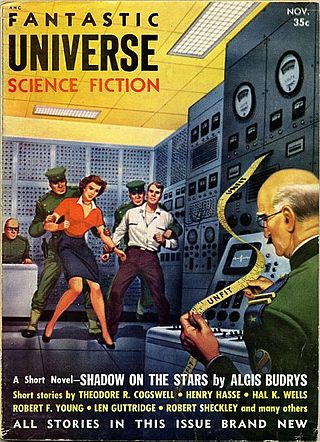
Fantastic Universe was a U.S. science fiction magazine which began publishing in the 1950s. It ran for 69 issues, from June 1953 to March 1960, under two different publishers. It was part of the explosion of science fiction magazine publishing in the 1950s in the United States, and was moderately successful, outlasting almost all of its competitors. The main editors were Leo Margulies (1954–1956) and Hans Stefan Santesson (1956–1960).

Tomorrow Speculative Fiction was a science fiction magazine edited by Algis Budrys, published in print and online in the United States from 1993 to 1999. It was launched by Pulphouse Publishing as part of its attempt to move away from book publishing to magazines, but cash flow problems led Budrys to buy the magazine after the first issue and publish it himself. There were 24 issues as a print magazine from 1992 to 1997, mostly on a bimonthly schedule. The magazine was losing money, and in 1997 Budrys moved to online publishing, rebranding the magazine as tomorrowsf. Readership grew while the magazine was free to read on the web, but plummeted when Budrys began charging for subscriptions. In 1998 Budrys stopped acquiring new fiction, only publishing reprints of his own stories, and in 1999 he shut the magazine down.
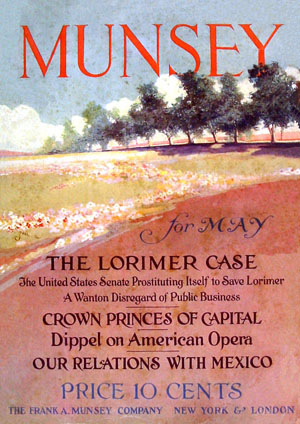
Munsey's Magazine was an American magazine founded by Frank Munsey in 1889 as Munsey's Weekly, a humor magazine edited by John Kendrick Bangs. It was unsuccessful, and by late 1891 had lost $100,000. Munsey converted it into an illustrated general monthly in October of that year, retitled Munsey's Magazine and priced at twenty-five cents. Richard Titherington became the editor, and remained in that role throughout the magazine's existence. In 1893 Munsey cut the price to ten cents. This brought him into conflict with the American News Company, which had a near-monopoly on magazine distribution, as they were unwilling to handle the magazine at the price Munsey proposed. Munsey started his own distribution company and was quickly successful: the first ten cent issue began with a print run of 20,000 copies but eventually sold 60,000, and within a year circulation had risen to over a quarter of a million copies.
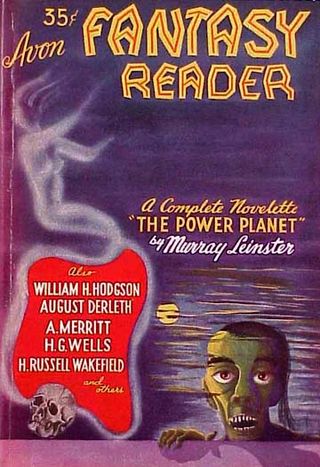
Avon published three related magazines in the late 1940s and early 1950s, titled Avon Fantasy Reader, Avon Science Fiction Reader, and Avon Science Fiction and Fantasy Reader. These were digest size magazines which reprinted science fiction and fantasy literature by now well-known authors. They were edited by Donald A. Wollheim and published by Avon.

The All-Story Magazine was a pulp magazine founded in 1905 and published by Frank Munsey. The editor was Robert H. Davis; Thomas Newell Metcalf also worked as a managing editor for the magazine. It was published monthly until March 1914, and then switched to a weekly schedule. Munsey merged it with TheCavalier, another of his pulp magazines, in May 1914, and the title changed to All-Story Cavalier Weekly for a year. In 1920 it was merged with Munsey's Argosy; the combined magazine was retitled Argosy All-Story Weekly.

Amazing Stories Annual was a pulp magazine which published a single issue in July 1927. It was edited by Hugo Gernsback, and featured the first publication of The Master Mind of Mars, by Edgar Rice Burroughs, which had been rejected by several other magazines, perhaps because the plot included a satire on religious fundamentalism. The other stories in Amazing Stories Annual were reprints, including two stories by A. Merritt, and one by H.G. Wells. The magazine sold out, and its success led Gernsback to launch Amazing Stories Quarterly the following year.
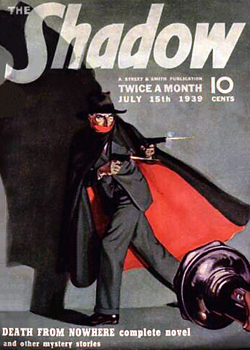
The Shadow was an American pulp magazine that was published by Street & Smith from 1931 to 1949. Each issue contained a novel about the Shadow, a mysterious crime-fighting figure who had been invented to narrate the introductions to radio broadcasts of stories from Street & Smith's Detective Story Magazine. A line from the introduction, "Who knows what evil lurks in the hearts of men? The Shadow knows", prompted listeners to ask at newsstands for the "Shadow magazine", which convinced the publisher that a magazine based around a single character could be successful. Walter Gibson persuaded the magazine's editor, Frank Blackwell, to let him write the first novel, The Living Shadow, which appeared in the first issue, dated April 1931.
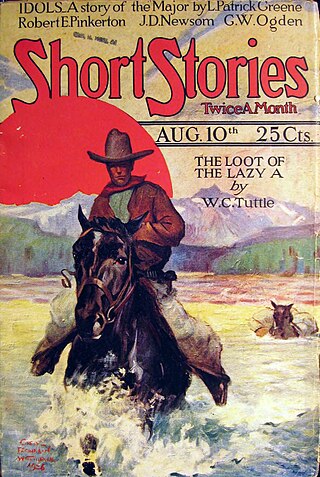
Short Stories was an American fiction magazine published between 1890 and 1959.

Doc Savage was an American pulp magazine that was published from 1933 to 1949 by Street & Smith. It was launched as a follow-up to the success of The Shadow, a magazine Street & Smith had started in 1931, based around a single character. Doc Savage's lead character, Clark Savage, was a scientist and adventurer, rather than purely a detective. Lester Dent was hired to write the lead novels, almost all of which were published under the house name "Kenneth Robeson". A few dozen novels were ghost-written by other writers, hired either by Dent or by Street & Smith. The magazine was successful, but was shut down in 1949 as part of Street & Smith's decision to abandon the pulp magazine field completely.

War Birds was a pulp magazine published by Dell from 1928 to 1937. It was the first pulp to focus on stories of war in the air, and soon had competitors. A series featuring fictional Irishman Terence X. O'Leary, which had started in other magazines, began to feature in War Birds in 1933, and in 1935 the magazine changed its name to Terence X. O'Leary's War Birds for three issues. In these issues the setting for stories about O'Leary changed from World War I to the near future; when the title changed back to War Birds later that year, the fiction reverted to ordinary aviation war stories for its last nine issues, including one final O'Leary story. The magazine's editors included Harry Steeger and Carson W. Mowre.

Mind Magic was an American pulp magazine which published six issues in 1931. The publisher was Shade Publishing Company of Philadelphia, and the editor was G.R. Bay. It focused on occult fantasy and non-fiction articles about occult topics. After four issues it changed its title to My Self, perhaps in order to broaden its appeal, but it ceased publication the following issue. Writers who appeared in its pages include Ralph Milne Farley, August Derleth, and Manly Wade Wellman.

Ace Mystery was a weird menace pulp magazine which published three issues starting in 1936, followed by two more under the title Detective Romances.

The Spider was an American pulp magazine published by Popular Publications from 1933 to 1943. Every issue included a lead novel featuring the Spider, a heroic crime-fighter. The magazine was intended as a rival to Street & Smith's The Shadow and Standard Magazine's The Phantom Detective, which also featured crime-fighting heroes. The novels in the first two issues were written by R. T. M. Scott; thereafter every lead novel was credited to "Grant Stockbridge", a house name. Norvell Page, a prolific pulp author, wrote most of these; almost all the rest were written by Emile Tepperman and A. H. Bittner. The novel in the final issue was written by Prentice Winchell.

Captain Zero was an American pulp magazine that published three issues in 1949 and 1950. The lead novels, written by G.T. Fleming-Roberts, featured Lee Allyn, who had been the subject of an experiment with radiation, and as a result was invisible between midnight and dawn. Under the name Captain Zero, Allyn became a vigilante, fighting crime at night. Allyn had no other superpowers, and the novels were straightforward mysteries in Weinberg's opinion, though pulp historian Robert Sampson considers them to be "complex...[they] pound along with hair-raising incidents..full of twists and high suspense". Captain Zero was the last crime-fighter hero magazine to be launched in the pulp era, ending an era that had begun with The Shadow in 1931. There was room in the magazine for only one or two short stories along with the lead novel; these were all straight mystery stories, without the veneer of science fiction of the Captain Zero novels.

Marvel Tales and Unusual Stories were two related American semi-professional science fiction magazines published in 1934 and 1935 by William L. Crawford. Crawford was a science fiction fan who believed that the pulp magazines of the time were too limited in what they would publish. In 1933, he distributed a flyer announcing Unusual Stories, and declaring that no taboos would prevent him from publishing worthwhile fiction. The flyer included a page from P. Schuyler Miller's "The Titan", which Miller had been unable to sell to the professional magazines because of its sexual content. A partial issue of Unusual Stories was distributed in early 1934, but Crawford then launched a new title, Marvel Tales, in May 1934. A total of five issues of Marvel Tales and three of Unusual Stories appeared over the next two years.

Nelly Littlehale Umbstaetter Murphy (1867–1941) was an American artist. She was born in Stockton, California, and moved to Boston when she married her first husband, Herman Umbstaetter. She drew many of the covers for The Black Cat, the magazine her husband edited from 1895 to 1912, and a collection of the covers was advertised as a free gift with subscriptions to the magazine in 1905. She studied with Joseph De Camp and Charles Howard Walker. Her first husband died in 1913, and she married Hermann Dudley Murphy in 1916. She died in 1941 in Lexington, Massachusetts. Her work is in the collection of the Addison Gallery of American Art and the Museum of Fine Arts, Boston. She was a member of the American Watercolor Society, the Copley Society of Art, and The Guild of Boston Artists. Her papers are in the Archives of American Art.
Herman Daniel Umbstaetter was an American businessman and founder of the magazine The Black Cat.
























